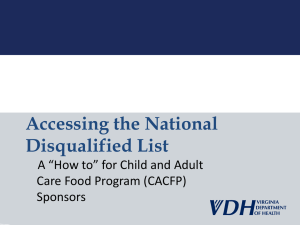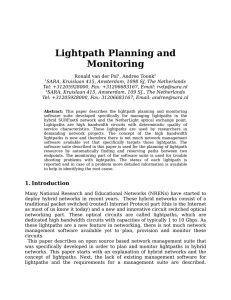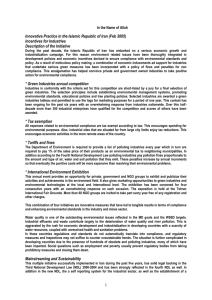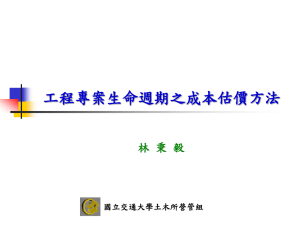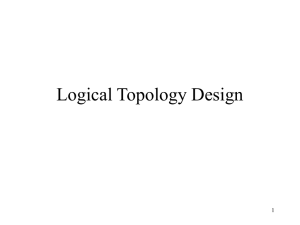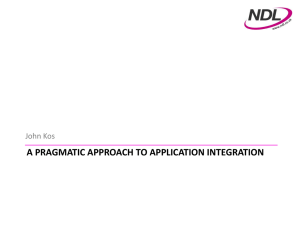Paper
advertisement
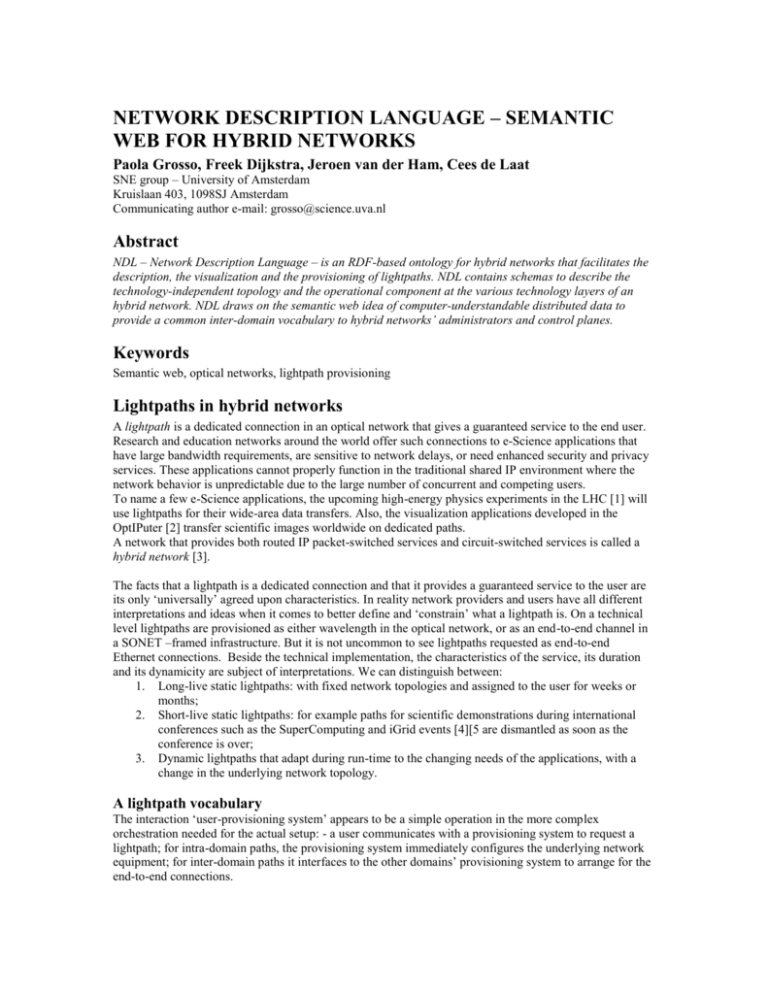
NETWORK DESCRIPTION LANGUAGE – SEMANTIC WEB FOR HYBRID NETWORKS Paola Grosso, Freek Dijkstra, Jeroen van der Ham, Cees de Laat SNE group – University of Amsterdam Kruislaan 403, 1098SJ Amsterdam Communicating author e-mail: grosso@science.uva.nl Abstract NDL – Network Description Language – is an RDF-based ontology for hybrid networks that facilitates the description, the visualization and the provisioning of lightpaths. NDL contains schemas to describe the technology-independent topology and the operational component at the various technology layers of an hybrid network. NDL draws on the semantic web idea of computer-understandable distributed data to provide a common inter-domain vocabulary to hybrid networks’ administrators and control planes. Keywords Semantic web, optical networks, lightpath provisioning Lightpaths in hybrid networks A lightpath is a dedicated connection in an optical network that gives a guaranteed service to the end user. Research and education networks around the world offer such connections to e-Science applications that have large bandwidth requirements, are sensitive to network delays, or need enhanced security and privacy services. These applications cannot properly function in the traditional shared IP environment where the network behavior is unpredictable due to the large number of concurrent and competing users. To name a few e-Science applications, the upcoming high-energy physics experiments in the LHC [1] will use lightpaths for their wide-area data transfers. Also, the visualization applications developed in the OptIPuter [2] transfer scientific images worldwide on dedicated paths. A network that provides both routed IP packet-switched services and circuit-switched services is called a hybrid network [3]. The facts that a lightpath is a dedicated connection and that it provides a guaranteed service to the user are its only ‘universally’ agreed upon characteristics. In reality network providers and users have all different interpretations and ideas when it comes to better define and ‘constrain’ what a lightpath is. On a technical level lightpaths are provisioned as either wavelength in the optical network, or as an end-to-end channel in a SONET –framed infrastructure. But it is not uncommon to see lightpaths requested as end-to-end Ethernet connections. Beside the technical implementation, the characteristics of the service, its duration and its dynamicity are subject of interpretations. We can distinguish between: 1. Long-live static lightpaths: with fixed network topologies and assigned to the user for weeks or months; 2. Short-live static lightpaths: for example paths for scientific demonstrations during international conferences such as the SuperComputing and iGrid events [4][5 are dismantled as soon as the conference is over; 3. Dynamic lightpaths that adapt during run-time to the changing needs of the applications, with a change in the underlying network topology. A lightpath vocabulary The interaction ‘user-provisioning system’ appears to be a simple operation in the more complex orchestration needed for the actual setup: - a user communicates with a provisioning system to request a lightpath; for intra-domain paths, the provisioning system immediately configures the underlying network equipment; for inter-domain paths it interfaces to the other domains’ provisioning system to arrange for the end-to-end connections. In reality this becomes a complicated procedure because of the lack of a common and unique understanding of what a lightpath is, as we just outlined in the previous section. At the same time the interaction between provisioning systems operating in different domains is hindered by the same lack of common ground. Operators need also a unique vocabulary to convey an unambiguous meaning to their lightpath requests exchanges. To fill these communication gaps we started to develop NDL – Network Description Language [6]. This is an ontology describing hybrid networks and specifically the aspects relevant to lightpath provisioning. It is intended as an aid to the communication between user and providers, and between providers. The novelty of NDL is its foundation on the ideas of semantic web and RDF, so that NDL defines more than a just meta-data schema but it also provides a flexible and extendible semantic model. In the rest of this article we will introduce semantic web and RDF; we will give an overview of the current NDL schemas and their applications; we will conclude outlining future work directions. Semantic web for lightpaths The Semantic Web is a web in which data is organized according to semantic meaning. This allows applications and computers, not only humans, to ‘reason’ on the data and derive logical connections between entities. The Semantic Web concept allows integration of information from different sources and from very different fields of knowledge. The way to achieve this is the definition of ontologies; ontologies classify and categorize the data and provide the relationship between the defined categories [7]. Looking at hybrid networks we see that the setup of a lightpath is a process that sees many parties involved: the requesting user and the management plane in each domain the lightpath goes through. We already said these parties lack a common vocabulary. This is where using the Semantic Web comes to our help. It encourages the definition of an ontology for hybrid networks and lightpaths that can act as the common language to all parties involved. It also allows to re-use all the tools that are available for ‘processing’ and ‘consumption’ of semantically organized data. Finally, engrained in the Semantic Web concept is the idea that data is distributed and held by different owners, each independent from the other. Network owners maintain full independence in publishing and updating their network information; other network ownsers can easily consume this information as long as it abides to the common ontology. NDL is the Semantic Web based language we propose for use in hybrid networks. RDF NDL is based on RDF, the Resource Description Framework. RDF uses a triple-based model to represent resources and the relationship between them, as shown in Fig. 1. Fig.1. RDF triplet The predicate defines a property of the subject; and the object is the value of such property. RDF identifies subject, object and predicate with URIs - Universal Resource Identifiers. Some objects are literal strings, instead of URIs. To encode RDF graphs and exchange RDF-structured information we need a language to express the triplet concept. There are three main ways to do this: RDF/XML, an XML-based syntax that we are currently using in NDL; Notation3 (or N3) that provides a more human-readable alternative to RDF/XML, and finally N-Triple, a subset of N3. There are a few common properties defined in RDF that we have used in our ontology to achieve a more clear logical structure. The range property and the domain property; they both refer to an RDF predicate and define its scope. The range of a predicate indicates which objects are valid values for the property; the domain of a predicate indicates which subjects are valid resources for such a property. To refer to information defined remotely we can use the isDefinedBy property of a subject. With isDefinedBy a subject points to a resource that might provide additional information about the subject resource. NDL schemas Hybrid networks users and providers can rely on NDL to exchange information with a well-defined and unambiguous meaning. NDL classes and properties are organized in five schemas [8]: The topology schema that describes devices, interfaces and links and connections between them on a single layer; The layer schema that describes specific network technologies, and the relation between network layers; The capability schema that describes device capabilities; The domain schema that describes administrative domains, services within a domain, and how to give an abstracted view of the network in a domain; The physical schema that describes the physical aspects of network elements and the layout of devices with blades and chassis. In the following two sections we give a more through overview of the topology schema and the layer schema. NDL topology schema The topology schema was the first schema we created. Its classes and properties describe the topology of a hybrid network, without detailed information on the technical aspects of the connections and their operating layer. The idea is that that through this lightweight schema we can provide an easy toolset for basic information exchange and path finding. In Fig.2 we see the topology classes and properties: Fig.2. NDL topology schema The relation between the classes in this schema is in Fig.3: Fig.3. NDL topology classes A Device represents a physical or an abstract network element. In the topology schema we use the classes Interface and Link to create connections between devices. There are four properties to do this: connectedTo and linkTo, switchedTo and packetSwitchedTo: The connectedTo property ties Interfaces together. It defines uni-directional connections between Interfaces, or from Interfaces to Links. All data send out the subject Interface (the egress interface) is somehow received by to the object Interface (the ingress interface). To define a bi-directional connection with the connectedTo property it should be defined in both directions, with both Interfaces pointing to each other or both Interfaces pointing to the same Link. A connectedTo property always involves external connection, between devices, not connections within a device: for that we define the switchedTo property. The subject and object Interface must be on the same layer. The linkTo is a subProperty of connectedTo. It defines that the subject and object Interface are directly connected to each other on their layer. There is no intermediate connection point forwarding the data. The switchedTo property represents an internal uni-directional connection within a device. All data from the subject is forwarded to the object. A switchedTo property always involves internal connection, within devices, not connections between two devices. To define a bi-directional connection with the switchedTo property it should be defined in both directions. The packetSwitchedTo property is a variant of the switchedTo property. When we define two switchedTo properties with the same Interface as object the result is that only one of the data streams is carried on the object Interface. The packetSwitchedTo properties on the other hand means that the data of the all subject Interfaces is somehow merged and forward on the object Interface. The immediate applications of the topology schema are generation of network map and input to path finding systems. We will discuss this in more detail in the NDL applications section. NDL layer schema To provision a lightpath we need more information than the one contained in the topology schema. We need to define layers and relation between layers: this aids path finding in multilayer environments in which domains operate with different technologies. To facilitate this task we developed the NDL layer schema. The layer schema is a vocabulary for defining network layers and interrelations between layers. Fig. 4 shows the classes and properties in this schema. Fig.4. NDL layer schema A Layer is a specific encoding in network connection; most Layers have an associated Label Set that defines which channels are used to make switching decision in a device. Each Interface Class operates at a certain Layer. When data needs to move from one layer to another we use Adaptation. The concept of client and server refer to the Layers before and after the Adaptation. This way we can see if the requested path can be configured end-to-end. If the data needs to travel through devices that are on different layer, we need to check if the interfaces on these devices can adapt the data. NDL applications In hybrid networks there are immediate applications for NDL: we can for example use it to generate up-todate network maps, to provide input data to path finding algorithms, or to provide input for detect errors and faults in existing lightpaths. In the following sections we will cover these applications in more detail. Network maps The setup of lightpaths within a domain or between domains is not (yet) an automated process. Often network administrators exchange information about the topology of their network using network maps. These maps need to be up-to-date and offer a view of the devices and interfaces available for path setup. Thanks to these maps engineers can see if end-to-end paths are possible. If a hybrid network describes its internal topology in NDL it can use this as input to visualization applications. A first simple use case is the generation of maps of a single domain. A more complex application that fully exploits the semantic model of RDF is the generation of inter-domain maps. In this latter case a web crawler gathers information from different domains that are interconnected and uses this to produce global maps. We provide NDL users with visualization tools, based on GraphViz [9] and Google Maps [10]. GraphViz is an open source visualization tool that draws graphs starting from information expressed in the DOT language. We use a simple script to extract the data from NDL files using SPARQL queries, and we feed it to GraphViz to show which devices, which interfaces and which connections are present in a domain. The resulting maps are especially useful at the intra-domain level. We have used this tool to model the NetherLight network in the Netherlands. NetherLight is Fig. 5 shows a map of such network. Fig.5. A graph of the NetherLight network resources Using GoogleMaps is instead very handy when we want to display the connections between separate domains on a global scale. The NDL topology schema contains geographic information, latitude and longitude, of the location of devices. We can correlate information contained in distributed NDL files, one per domain; the RDF isDefinedBy property allows us to navigate between the information published autonomously by each domain. We can then place the various elements in a world map and get an overview of the lightpaths and interconnections between the various domains. We have used this tool to model the GLIF network. GLIF is an international virtual organization of research networks, research consortia and institutions whose aim is to build a worldwide networking facility for scientific research. GLIF consists of a collection of optical exchange points, GOLEs - GLIF Open Lightpath Exchanges, spread over North America, Europe, East Asia, and Australia, with numerous links across and between the continents. Fig.6 shows the GLIF map obtained using distributed NDL files. Fig.6. A graph of GLIF lightpaths Path finding Given a single hybrid network or a group of interconnected hybrid networks described in NDL we can use this information to find the possible lightpaths between end points. A demonstration of this NDL capability was shown during the SuperComputing conference of 2006 in Tampa, FL. Together with SARA, the Dutch Academic SuperComputing Center, we developed an application to find lightpaths in the GLIF. In the GLIF the various participating GLIF domains describe their optical exchange points network topology with NDL and publishe these files autonomously on the Web. They point to each other descriptions using the isDefinedBy property and maintain only their local information. A crawler tool travels through the chain of RDF files via the isDefinedBy connections and collects the distributed information into a global topology database. A path finding algorithm uses this topology database to answer request for lightpaths from user. Fault isolation After the initial provisioning of a multi-domain and multi-layer lightpath, time is often spent ‘debugging’ this newly created connection. Fault detection is the process of detecting that a connection that is not working as it should be and of determining what causes the malfunction. NDL facilitates the fault isolation process in hybrid networks. Fault isolation software can in fact use NDL information as input to get an overview of the devices and interfaces part of the overall connection. This information can be used to find inconsistency in configuration and to pinpoint possible misconfigurations. Future work We are currently looking at extensions of NDL that cover two important aspects of the inter-domain lightpath provisioning process: the exchange of topology information between control plane applications and the integration with authorization policies. Network abstractions When lightpaths extend beyond one domain into another one we often have two different provisioning applications needing to communicate with each other. In the hybrid networking community the mechanisms for data exchange at the NNI – Network-Network Interfaces – are not yet well defined: on one hand one if both systems use GMPLS (Generalized Multiprotocol Label Switching) one could extend seamlessly signaling at the boundary. But even in that case, or in the case the two provisioning systems are not GMPLS-based, we can take a pull approach in which an initiating domain requests information from the downstream. The integration of Network Resource Provisioning Systems is a central research question, addresses for example in project such as Phosphorus [11]. We intend to propose NDL as the information model for information exchange at the domain boundaries. For this purpose we propose the use of the domain schema. A domain will not publish to neighbors full topologies but only abstracted views that contain sufficient information for the other provisioning system to extend a path into it. Such a schema will contain information on entry and exit points in the domain, their properties and any eventual inner information needed to request a path extension into it. Multi layer path finding The path finding algorithms presented during SC|06 made use of the layer-agnostic topology schema. We are now looking at extending path finding algorithms to multi layer networks, where devices operate with different technologies. This use case is much more realistic in representing the actual implementations of lightpaths in intra and inter-domain environments. Policy In a multi-domain environment the setup of a lightpath is not merely a technical issue, of operating at consistent network layers, or linking interfaces with same capacities or handling routing information exchange. It is also subordinated to authorization policies set forth by each domain’s administrators. Such policies determine if and which users have access to the network resources and which mutual cooperation agreements exist between domains. We are working at incorporating into the NDL ontologies the concept of policy, so that users and applications looking for a lightpath would know who to contact. A brokering service in a multi-domain environment would fetch NDL files for each of the domain, and find together with the network topology description the pointer to where the policy is to be found. Conclusions NDL – Network Description Language – is an RDF based model for hybrid networks that provides a semantic for information exchange to lightpath provisioning systems and end user. NDL defines several schemas for topology and technology information. It has been used for lightpath visualizations, lightpath finding and lightpath fault isolations. Currently we look at extending NDL to describe domains in abstract terms with sufficient information for inter-domain path provisioning; to perform multi-layer path finding and to integrate it with authorization policies models. NDL strengths lie in its abstract model that describes multilayer hybrid network without being technology specific; in being loosely coupled so that domains have a way to exchange information; and finally in its flexibility and extensibility. Acknowledgments We thank our colleagues Andree Toonk and Ronald van der Pol from SARA and Franco Travostino from eBay (formerly NORTEL) for their collaboration on this work. This work is supported by SURFnet, the BSIK GigaPort project and TNO. References [1] LHC – Large Hadron Collider, URL: http://lhc.web.cern.ch/lhc/ [2] OptIPuter - A Powerful Distributed Cyberinfrastructure to Support Data-Intensive Scientific Research and Collaboration, URL: http://www.optiputer.net/ [3] Cees de Laat, Erik Radius, Steven Wallace: “The rationale of the current optical networking initiatives”, Future Generation Computer Systems, Vol.22, Issue 6, pp. 999-1008, 2003 [4] SuperComputing – The International Conference for High Performance Computing, Networking, Storage, and Analysis, URL: http://www.supercomp.org/ [5] iGrid – The International Grid, URL: http://www.igrid2005.org [6] Jeroen van der Ham, Freek Dijkstra, Franco Travostino, Hubertus Andree and Cees de Laat: “Using RDF to Describe Networks”, Future Generation Computer Systems, Vol. 22, Issue 8, pp. 908-914, 2006 [7] Nigel Shadbolt, Tim Berners-Lee, and Wendy Hall: “The Semantic Web Revisited”, IEEE Intelligent Systems, Vol. 21, Issue 3, pp. 96 -101, 2006 [8] NDL – Network Description Language, URL: http://www.science.uva.nl/research/sne/ndl/ [9] Graphviz – graph visualization software, URL: http://www.graphviz.org/ [10] Google, Google maps, URL: http://maps.google.com/ [11] Phosphorus, URL: http://www.ist-phosphorus.eu
